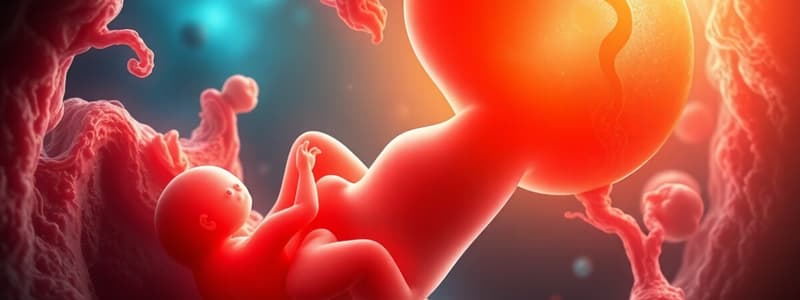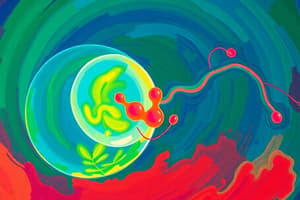Podcast
Questions and Answers
Which of the following structures is responsible for producing blood cells for the embryo until it can produce its own?
Which of the following structures is responsible for producing blood cells for the embryo until it can produce its own?
- Yolk sac (correct)
- Placenta
- Chorion
- Amnion
During which period of prenatal development does the neural tube form?
During which period of prenatal development does the neural tube form?
- Period of the zygote
- Period of the embryo (correct)
- Period of the fetus
- All of the above
What is the primary function of the trophoblast cells?
What is the primary function of the trophoblast cells?
- Protect and nourish the developing embryo (correct)
- Develop into the nervous system and skin
- Produce the amniotic fluid
- Form the embryo's digestive system
Which of the following structures is NOT formed during the second month of prenatal development?
Which of the following structures is NOT formed during the second month of prenatal development?
At what stage of development does the blastocyst implant in the uterine wall?
At what stage of development does the blastocyst implant in the uterine wall?
What is the approximate size of the embryo at the end of the second month of development?
What is the approximate size of the embryo at the end of the second month of development?
Which of the following layers of the embryonic disk becomes the muscles, bones, and circulatory system?
Which of the following layers of the embryonic disk becomes the muscles, bones, and circulatory system?
What does the amnion do?
What does the amnion do?
What is the primary function of the placenta?
What is the primary function of the placenta?
What significant developmental change occurs during the second trimester?
What significant developmental change occurs during the second trimester?
What is the primary effect of rubella on an unborn child?
What is the primary effect of rubella on an unborn child?
When do teratogens have the strongest impact on a developing fetus?
When do teratogens have the strongest impact on a developing fetus?
What is lanugo and when does it appear?
What is lanugo and when does it appear?
During which stage of pregnancy is toxoplasmosis most harmful to the unborn child?
During which stage of pregnancy is toxoplasmosis most harmful to the unborn child?
At what point can syphilis begin to impact the unborn child?
At what point can syphilis begin to impact the unborn child?
At what stage can an ultrasound determine the sex of the baby?
At what stage can an ultrasound determine the sex of the baby?
What is a potential effect of genital herpes on an unborn child?
What is a potential effect of genital herpes on an unborn child?
What significant event occurs during the third month of development?
What significant event occurs during the third month of development?
What does the age of viability refer to?
What does the age of viability refer to?
What impact can HIV/AIDS have on an unborn child in developing countries?
What impact can HIV/AIDS have on an unborn child in developing countries?
What is the structural abnormality caused by thalidomide known as?
What is the structural abnormality caused by thalidomide known as?
What is vernix and when does it typically appear?
What is vernix and when does it typically appear?
What condition is associated with heavy alcohol consumption during pregnancy?
What condition is associated with heavy alcohol consumption during pregnancy?
How do children with fetal alcohol spectrum disorder (FASD) compare to children with ADHD regarding self-regulation?
How do children with fetal alcohol spectrum disorder (FASD) compare to children with ADHD regarding self-regulation?
What are the effects of fetal alcohol exposure?
What are the effects of fetal alcohol exposure?
What impact does cigarette smoking during pregnancy have on the child?
What impact does cigarette smoking during pregnancy have on the child?
Which of the following is a consequence of cocaine use during pregnancy?
Which of the following is a consequence of cocaine use during pregnancy?
What can happen to a child born to a mother who used heroin during pregnancy?
What can happen to a child born to a mother who used heroin during pregnancy?
What is a possible effect of radiation exposure on an unborn child?
What is a possible effect of radiation exposure on an unborn child?
What maternal nutrient deficiency can lead to congenital hypothyroidism?
What maternal nutrient deficiency can lead to congenital hypothyroidism?
Which age group of mothers is linked to higher risks during pregnancy?
Which age group of mothers is linked to higher risks during pregnancy?
How can maternal stress affect the unborn child?
How can maternal stress affect the unborn child?
Flashcards
Germline Period
Germline Period
Period from conception to implantation in the uterine wall.
Period of the Embryo
Period of the Embryo
Weeks 3 to 8 of prenatal development, when major systems begin to form.
Blastocyst
Blastocyst
A ball of cells formed from a fertilized egg before implantation.
Ectoderm
Ectoderm
Signup and view all the flashcards
Neural Tube
Neural Tube
Signup and view all the flashcards
Mesoderm
Mesoderm
Signup and view all the flashcards
Endoderm
Endoderm
Signup and view all the flashcards
Amnion
Amnion
Signup and view all the flashcards
Chorion
Chorion
Signup and view all the flashcards
Placenta
Placenta
Signup and view all the flashcards
Umbilical Cord
Umbilical Cord
Signup and view all the flashcards
Second Trimester
Second Trimester
Signup and view all the flashcards
Vernix
Vernix
Signup and view all the flashcards
Lanugo
Lanugo
Signup and view all the flashcards
Age of Viability
Age of Viability
Signup and view all the flashcards
Teratogens
Teratogens
Signup and view all the flashcards
Fetal Alcohol Effects (FAE)
Fetal Alcohol Effects (FAE)
Signup and view all the flashcards
Cigarette Smoking During Pregnancy
Cigarette Smoking During Pregnancy
Signup and view all the flashcards
Cocaine Use During Pregnancy
Cocaine Use During Pregnancy
Signup and view all the flashcards
Effects of Heroin Use
Effects of Heroin Use
Signup and view all the flashcards
Radiation Exposure Effects
Radiation Exposure Effects
Signup and view all the flashcards
Environmental Toxins
Environmental Toxins
Signup and view all the flashcards
Recommended Weight Gain in Pregnancy
Recommended Weight Gain in Pregnancy
Signup and view all the flashcards
Maternal Stress Impact
Maternal Stress Impact
Signup and view all the flashcards
Rubella
Rubella
Signup and view all the flashcards
Toxoplasmosis
Toxoplasmosis
Signup and view all the flashcards
Syphilis
Syphilis
Signup and view all the flashcards
Genital Herpes
Genital Herpes
Signup and view all the flashcards
HIV/AIDS
HIV/AIDS
Signup and view all the flashcards
Thalidomide
Thalidomide
Signup and view all the flashcards
Fetal Alcohol Spectrum Disorder (FASD)
Fetal Alcohol Spectrum Disorder (FASD)
Signup and view all the flashcards
Fetal Alcohol Syndrome (FAS)
Fetal Alcohol Syndrome (FAS)
Signup and view all the flashcards
Study Notes
Prenatal Development
- Period of the Zygote: From conception to implantation in uterine wall
- Period of the Embryo: Weeks 3 to 8
- Period of the Fetus: Weeks 9 to birth
- Zygote Timestamps: Single-cell mature ovum released from the ovary on days 9-16 of menstrual cycle; fertilization occurs within 24 hours; 2 cells at 36 hours, 4 cells at 48 hours, 16-32 cells at 72 hours; cell division forms inner cell mass at 4-5 days; blastocyst attaches to uterine wall (8-14 days).
- Blastocyst: Ball of cells formed when fertilized egg begins dividing; inner layer is the embryonic disk, which becomes the embryo; outer layer is trophoblasts (protects and nourishes embryo).
- Implantation: Blastocyst attaching to uterine wall
- Embryo Period: Formation of three cell layers (ectoderm, mesoderm, endoderm); ectoderm forms the nervous system, skin, and hair; neural tube develops from ectoderm (central nervous system); mesoderm forms muscles, bones, and circulatory system; endoderm forms digestive system, lungs, and vital organs.
- Significant Event (Week 4): Heart starts beating.
- Significant Events (Second Month): Ears, beginnings of skeleton, limbs develop.
- Embryo Size (Second Month): 2.5 cm long, 7g
- Support Structures (Post-Implantation): Amnion (watertight membrane) surrounds and cushions embryo and yolk sac, produces blood cells until the embryo develops its own blood cell production; chorion surrounds amnion and attaches to uterine tissue for nourishment and waste elimination; placenta forms from lining of chorion and uterine tissue for respiration, nutrition, and waste elimination; umbilical cord connects embryo to placenta to deliver oxygen.
- Third Month Development: Able to kick; twist; swallows; digests; urinates; male testes secrete testosterone; size 7.5 cm long; 28 g.
- Second Trimester (Months 4-6): Refined motor skills (suck thumb); mother feels the kicks; heartbeat, eyebrows, eyelashes, and hair appear; covered in vernix and lanugo.
- Vernix: White substance coating fetus to prevent chapped skin (appears 5-6 months).
- Lanugo: Fine layer of body hair allowing vernix to stick to fetus's skin (appears 5-6 months).
- Third Trimester (Months 7-9): Organ systems mature; weight gain; age of viability (22-28 weeks), possible survival outside uterus; fetus moves to head-down position; size 48-53 cm; 3.2-3.6 kg.
Teratogens
- Environmental Agents: Substances or conditions that can harm developing fetus (viruses, drugs, chemicals, radiation).
- Critical Phase of Pregnancy: When particular structures form and grow rapidly; most teratogens have strongest impact during this phase.
- Rubella: Maternal disease that can cause blindness, deafness, and cardiac effects in the unborn child. Risk greatest during first trimester.
- Toxoplasmosis: Maternal disease caused by a parasite (present in raw meat, cat feces); causes eye and brain damage; risk highest in first trimester.
- Syphilis: Sexually transmitted disease; can harm the unborn child. Risk increases as pregnancy progresses; miscarriage possible.
- Genital Herpes: Sexually transmitted disease; brain damage and neurological disorders possible during birth or contact.
Other Prenatal Development Factors
- Thalidomide: Mild tranquilizer; causes limb malformations.
- Diethylstilbestrol (DES): Synthetic hormone; linked to cervical cancer and genital abnormalities in female children.
- Fetal Alcohol Spectrum Disorder (FASD): Congenital problems resulting from alcohol consumption; self-regulation and intellectual development problems. (worse ADHD)
- Fetal Alcohol Syndrome (FAS): Severe version of FASD; microcephaly, facial malformations, hyperactivity, seizures, and low average intelligence.
- Fetal Alcohol Effects (FAE): Mild version of FASD; motor skills and attention problems are below average intellectually
- Cigarette Smoking (Pregnancy): Slows fetal growth; lower birth weights; cleft lip and palate; miscarriage or stillbirth risk.
- Cocaine Use (Pregnancy): Premature birth; smaller babies; lower IQ
- Heroin Use (Pregnancy): Increased neonatal death rate; newborns may be addicted.
- Marijuana Use (Pregnancy): Emotional, behavioral, and academic problems in the child.
- Radiation Exposure (Pregnancy): Physical deformities, intellectual disabilities, or death.
Recommendations and Safeguards
- Recommended Weight Gain (Pregnancy): 11-14 kg
- Iodine Consumption (Pregnancy): Crucial; deficiency linked to congenital hypothyroidism and cretinism.
- Folate (Folic Acid) Consumption (Pregnancy): Necessary for neural tube development; deficiency linked to spina bifida and anencephaly.
- Stress (Pregnancy): Linked to negative effects on the unborn child; prenatal growth stunting and lower birth weight are possible
- Maternal Age: Teen mothers (under 20) and mothers over 35 years of age experience heightened risks.
- Environmental Toxins: Pregnant woman and partner should attempt to limit exposure to environmental toxins.
- Safest Time Frame to Have Children: 20-35 years.
Studying That Suits You
Use AI to generate personalized quizzes and flashcards to suit your learning preferences.




